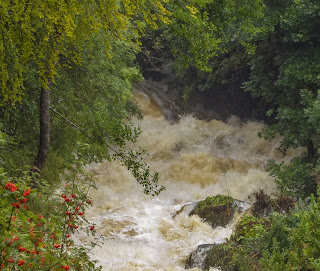The path rises steeply behind the cottages and all the while there is thissplendid view of the valley and The Old Man. I have taken this photograph many times, but who could argue that one more would be too many. It is just an irresistable view!
The old mine workings are everywhere, indeed Wainwright referred to Wetherlam as "the hollow mountain". The tips and what remains of the mines and buildings are a part of the landscape. They don't detract from the natural beaut of the surroundings, rather they add interest and intrigue, as I climb up the mountains I cannot help but wonder about the lives and living conditions of my ancestors that worked here.
This feature in the landscape can also be seen in the previous picture. It is of a mine known as Simon's Nick and local legend says that Simon was out prospecting around Levers Water one day when he discovered a rich vein of copper. Delighted with his discovery and the thought of riches to follow, he headed down to The Black Bull in the village for a celebratory drink. Others in the pub that night were curious to know the nature of his celebration and as he drank more he began to talk more. The legend says that he said far too much, because when he returned to his newly discovered source of wealth the next day, it had all gone. The vein had been worked out, leaving the cleft in the ridge that you can see in the photo. As with all legends there may well be some truth there, but I suspect tat there is very little accuracy.
Irene, heading down Tilberthwaite Ghyll.
Once down to valley level there is a good path through Yewdale Woods back to the village.
As the copper became harder and harder to mine, or perhaps more accurately, less economical to mine, the industry turned towards slate. There was after all a ready made workforce on hand, the miner's skills being readily transferable to quarrying. The above picture shows quarries on the front of The Old Man in a very straight vertical line. There must have been a very good vein of slate there.
High above Coppermines Valley and under the shoulder of Wetherlam, the path levels out and heads towards Tilberthwaite. Known locally as The Miner's Path, it connects the two copper mining areas of Tilberthwaite and Coppermines Valley.
Yewdale beck rises here in the boggy ground of the Tilberthwaite fells. The Mountain Ash or Rowan trees are covered with their bright red berries this year.
Looking into the entrance of the Tilberthwaite mine. Not a place to venture unless you have a knowledgeable guide. The mines are increadibly dangerous places with ancient, wet and rotting timbers and floors that look solid, but are suspended on rotten timbers. There are many hidden dangers. DO NOT GO IN!
The beck gathers pace and heads down past the village of Coniston to the lake.
Once down to valley level there is a good path through Yewdale Woods back to the village.
We took a slight diversion from Low Yewdale to prolong our walk on this beautiful day. We walked over Guards Wood and returned to the village near the football club.
The path follows part of the Cumbria Way and goes past this interesting looking building. It is a 19th century folly, built by John Marshall, a local land owner and has been used as a dog kennel for hounds and as a barn. The National Trust have restored it to it's original state and feature several orientation boards inside.






















































